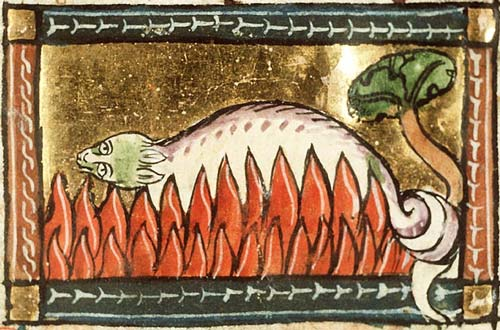Giant Salamanders in Loch Ness?
Posted by: Nick Redfern on January 22nd, 2013

It’s fair to say I find it very difficult these days to get enthused about anything connected to the saga of the Loch Ness Monster, chiefly as a result of hoaxes and dwindling numbers of good sightings.
But, there is one exception…
That exception is Steve Plambeck’s blog, The Loch Ness Giant Salamander.
As its title suggests, the blog (and Steve’s research) offers the possibility that the Nessies are not the plesiosaurs or giant eels that many conclude them to be.
And, while some may scoff at the idea that the Nessies are over-sized salamanders, I would urge one and all to check out Steve’s blog, as he does hit upon some interesting data that adds weight to his theories.
As a perfect example, check out the new post on this very matter, which Steve has just posted.
About Nick Redfern
Punk music fan, Tennents Super and Carlsberg Special Brew beer fan, horror film fan, chocolate fan, like to wear black clothes, like to stay up late. Work as a writer.










I do feel that a giant salamander is the most scientifically plausible explanation for the Loch Ness Monster.
What a problem here, folks, no feces.
Giant salamanders in the mountains of China and Japan are confirmed species.
Giant salamanders found in the Sacramento River have been caught there, reportedly.
Giant salamanders have been often sighted in the Trinity Alps, allegedly.
Giant salamanders exist as cryptids in Northern California, therefore.
Biogeographically, those two areas – redwoods and more – are alike, at their core.
Japan and California are so dissimilar to Scotland one wonders why such thoughts are biologically on file.
Loch Ness and giant salamanders, now that’s a doubtful theory, Ringo.
Forget about amphibians, eels, or even an ancient marine reptile.
Loch Ness and an elongated form of pinniped, bingo.
As of yet, there are no species of “deep water” salamanders. Present and fossil forms are all found in shallow water environs. The Asian “Giant Salamanders” can breathe through their skins (especially the Chinese form) and could go undetected at the surface. These forms need fast moving, well oxygenated water which I understand Loch Ness is at levels under 33m of depth. A deep water form of salamander is possible but as yet…undiscovered.
really curious what you guys think it is?
we really don’t hear much about loch ness these days either…
In my opinion it’s just another theory to cloud the already murky mystery that has had no foundation since its inception. Why create another implausible theory? Nessie is akin to Jack The Ripper!
My only hesitation with a pinniped being responsible is that stray seals from the coasts of Scotland are not uncommon in the loch, and they are spotted fairly soon, as they do spend a good deal of time at the surface. Any other pinniped species would likely do the same.
The water of Loch Ness below about 100 ft is highly oxygenated, 80% saturated if I recall, and remains at a fairly consistent cold temperature there year round. Several rivers flow into it, and there is only one outlet. While the flow rate may not be fast, there certainly would be a flow of water I suspect.
Clever, Loren.
However, a seal of any kind could not hide in the Loch.
As its need for air would drive it to the top.
Once there it would most certainly be spied
no matter its desire to hide.
So our search for the monster must persist
for I fear that your pinniped is too easily dismissed.
(P.S. Loren, I pray “this” isn’t the “transformation…(of your)blogging presence” that you alluded to!)
Deathstar666, I suppose the fish in Loch Ness probably would think of Nessie as The Ripper. Except that the recognized species of Giant Salamanders, the Cryptobranchidae, usually swallow their prey whole. Although I recently found they eat large eels as well, employing something of a spaghetti slurping tactic. There’s a video of this behavior on youtube but perhaps not for the faint of heart. Since the surest thing about Loch Ness, aside from its murkiness, may be its ample eel stocks, this may be one more reason a Loch Ness Giant Salamander would feel at home, although one my blog hasn’t explored yet.
Loren, in as much as the environment in Scotland is very unlike California, the lay term “giant” that gets applied to the modern lines of California and Pacific salamanders is more of a relative term than a taxonomic one. The true Giant Salamanders, the Cryptobranchidae, are from another and far more primitive order (some say sub-order) not closely related to these California species. The true Giant Salamanders, both Asian species as well as the Northeastern America Hellbender, are true living fossils. And a sister species of the *largest* form was spread across Northern Europe during the Miocene, quite recently in geological terms.
Cryptokellie, you’re right in as far as that goes. There are however marine (salt water) amphibia in the fossil record, and some very successful ones of the 15 to 30 foot variety were around for hundreds of millions of years, even dodging at least two of the three largest mass extinction events. And while it had once been assumed that living, fully aquatic amphibians dependent entirely on dermal respiration would only be found in fast moving, well oxygenated streams, when five living specimens of Atretochoana eiselti, the largest known lungless tetrapod, were finally captured live in Brazil about a year ago, they turned out to not only be 50% larger than the two known 18th century museum specimens (3 ft as opposed to 2 ft), but living in a warm, sluggish river! Nature still holds many surprises.
Nick – thanks for your feedback on my articles. It’s much appreciated.
Regards,
Steve
Dear Steve
You wrote: “Loren, in as much as the environment in Scotland is very unlike California, the lay term “giant” that gets applied to the modern lines of California and Pacific salamanders is more of a relative term than a taxonomic one. The true Giant Salamanders, the Cryptobranchidae, are from another and far more primitive order (some say sub-order) not closely related to these California species. The true Giant Salamanders, both Asian species as well as the Northeastern America Hellbender, are true living fossils. And a sister species of the *largest* form was spread across Northern Europe during the Miocene, quite recently in geological terms.”
I understand that, but you don’t seem to be aware of the reports, finds, and history of cryptozoology’s Giant Salamanders in California that match members of Cryptobranchidae. I’ve written extensively about them in my books on Tom Slick, who sponsored expeditions in search of the cryptid Giant Salamanders in the early 1960s. I was talking about the Trinity Alps Giant Salamanders, as possible new candidates of Cryptobranchidae, not the small, known species of “giant” salamanders in the Dicamptodontidae family.
https://cryptomundo.com//cryptozoo-news/cryptobranchidae/
Dear AreWeThereYeti
Oh, my
You do belie
You’ve been to college
But lack the knowledge
That Loch Ness Monsters walk on land
And don’t just lie in the sand.
The proposed Nessie cryptid seals
Breathe air, frolic about and take meals
While swimming in the haar.
They are sometimes seen there afar.
Dear Loren:
It is doubtful, that even when seen from afar
seals could be mistaken for other than what they are.
Tho some might be guilty of making hasty judgements,
a closer look shows nothing resembling plesiosaurs or sea serpents.
So, while “pinniped” may be what you, a priori, theorize
centuries of detailed sightings would suggest otherwise.
When discussing what might be the Monster of the Loch
we should first determine what it is not.
Let us completely exclude giant catfish, salamanders, worms and eels,
before settling for something as mundane as seals!
Pinnipeds, evolved, would hardly be mundane.
Prehistoric pinnipeds as relicts would not be arcane.
Enlongated pinnipeds aren’t chow-mein.
Cryptid pinnipeds do remain.
The haar gives eyestrain.
Difficult too to see in the rain.
Things at Ness are hard to explain.
These details are germane.
A new species may be there with a mane.
A new pinniped yet to obtain.
A new seal that’s not mundane.
https://cryptomundo.com//cryptozoo-news/parsons-1751/
It is Burns Night in Scotland. Please show some respect for the art!
@ wuffing: Agreed. Never again.
@ Loren: All this “versing” is killing me and not, I suspect, endearing us to the other readers, either!
So… I hereby (grudgingly) grant your mystery-pinniped theory my *seal* of approval.
Thank goodness – I had no idea how I was going to make any of the following rhyme!
Loren – Actually I am aware of and also intrigued by the Trinity Alps Giant Salamander, and rather optimistic that here we have an additional member for the Cryptobranchidae family — that would be good news indeed as populations of the three known species are crashing terribly fast. If I were forced to guess though, I’d think it more likely the Trinity Alps species would be most closely related to the Chinese Giant Salamander, with the Trinity Alps and Japanese variants both being derived species descended from the original Chinese stock.
On the other hand we have the Hynobiidae family in the same primitive suborder, which includes the amazingly cold-resistant Siberian Salamander. It’s not impossible some of these reached the western US through Alaska to found a new population at some point, the trouble here being that none of the species in this family are “giant”. I also don’t recall if the Hynobiidae have any fully aquatic members; it’s quite a lot of species.
The thing is, neither proving nor disproving the Trinity Alps Giant Salamander proves nor disproves the possibility of a Loch Ness Giant Salamander. And that works both ways of course. We cannot say the odds of one existing are diminished because the suborder or family of the other wouldn’t like the climate, without assuming a priori they are in the same suborder or family.
Or to put it another way: If Yeti really exist, then the odds of Sasquatch being closely related are high (provided Sasquatch also really exist) because there haven’t been a lot of large primates in the history of evolution, and they haven’t been around very long in geological terms. No two giant salamanders from opposite sides of the globe would have to be as closely related to each other to the same degree, because there have been many times more species of large Caudata than there have been of large primates, and going back not millions, but hundreds of millions of years longer.
The leopard seal has a pretty long neck…but I agree that it or a cousin would be easily recognized in Loch Ness.
The Salamander idea is very interesting to me tho’, because they can lay around on the bottom of rivers and ponds for a long time-also cold water not a huge problem AND they can go on land-which would explain some of the acounts of such.
And I believe they’ve been described as having “Feet” rather than flippers. The large eel population being a food source at loch Ness is also intriguing, especially since they tend to hang around near the bottom of of waters they inhabit.
Yep, I like the giant salamander theory better.